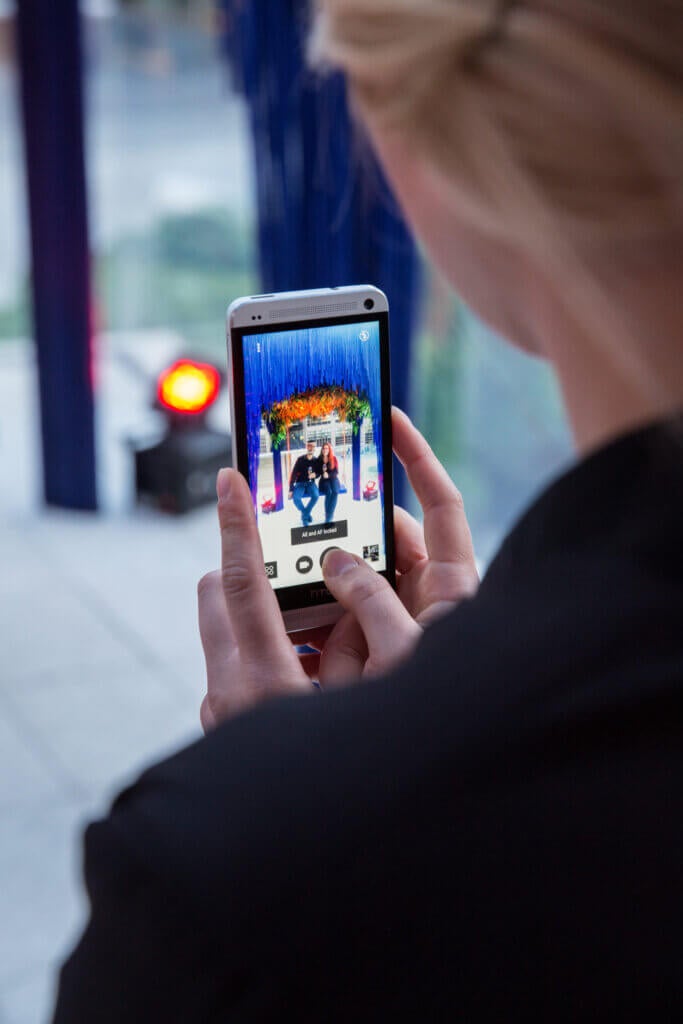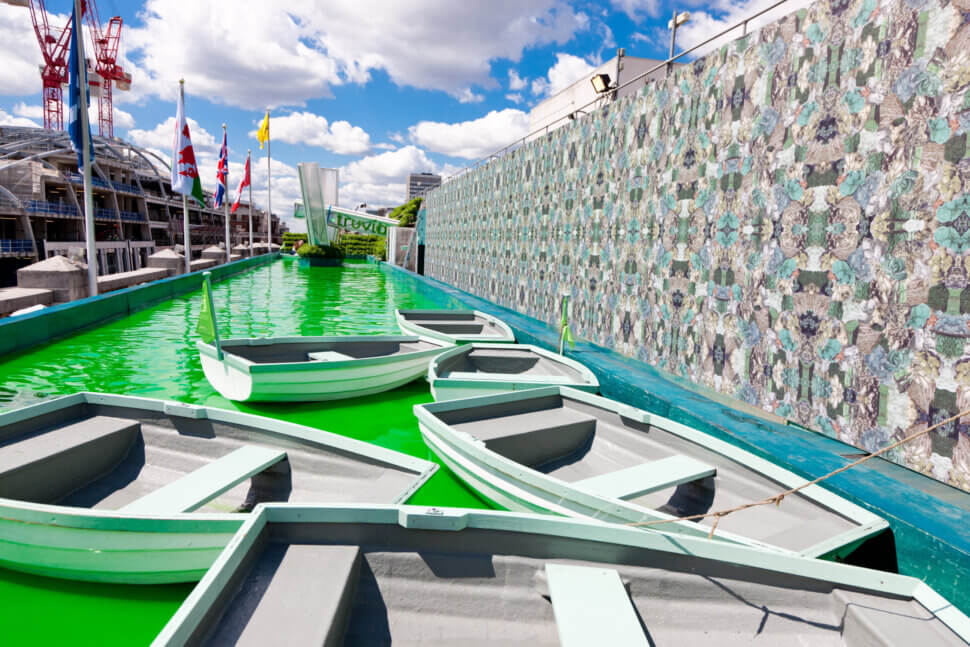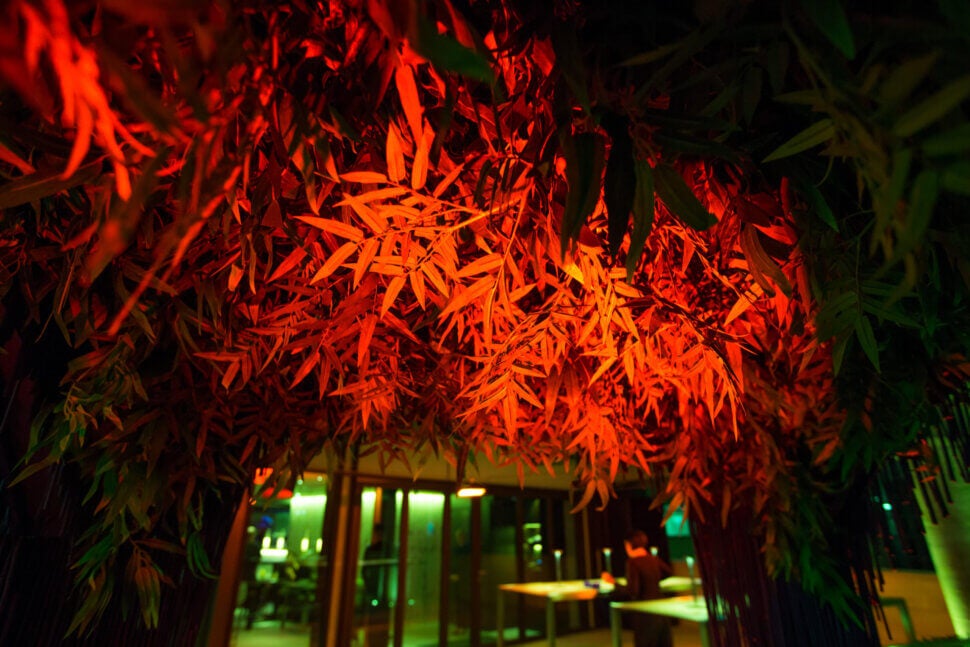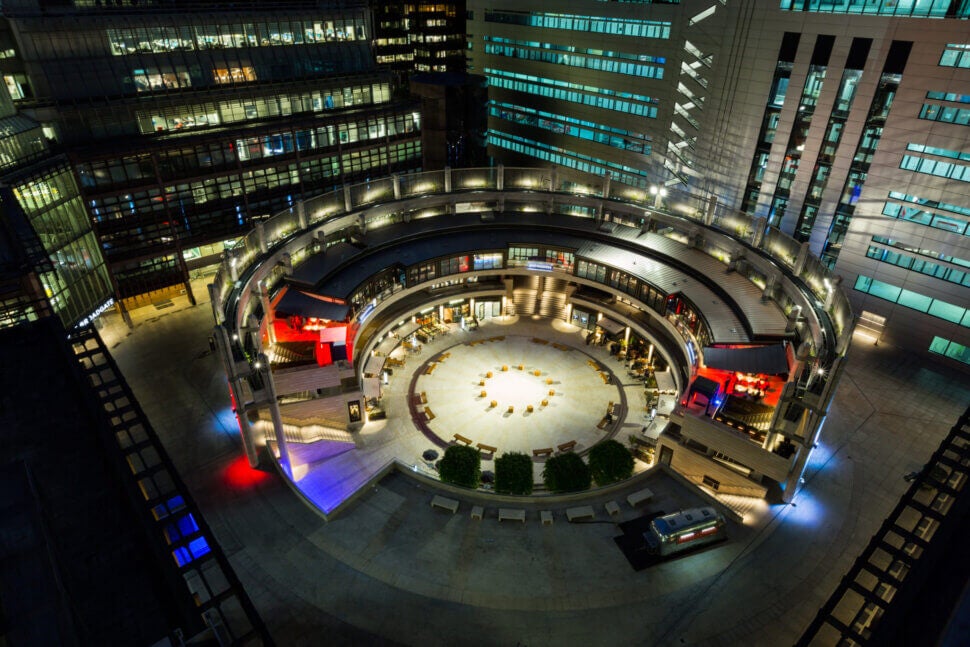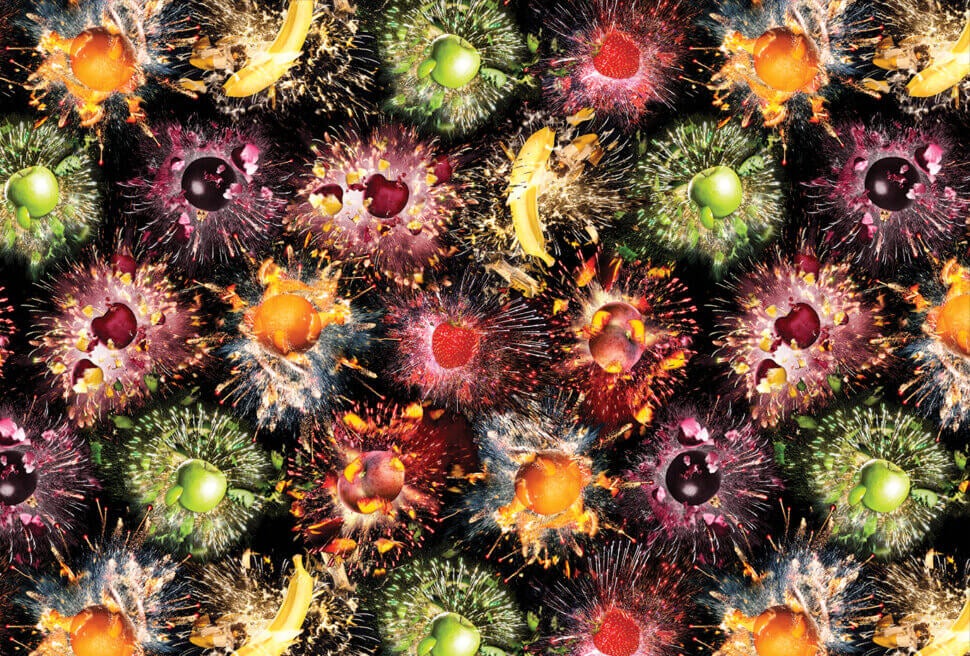On Breathable Cocktails and Cooking with Plasma: Bompas & Parr Talk Culinary Magic
June 11, 2019
Sam Bompas and Harry Parr are perhaps better known as the founders of Bompas & Parr, creatives specialising in culinary experiential installations.
They first rose to fame with their jelly artwork, but they have gone on to work with established brands on innovative projects to essentially change the boundaries of how we think about, talk about, and react with food.
Sam Bompas & Harry Parr enlist the help of both their in-house team of creatives – including cooks, technicians and architects – and industry experts from far and wide.
Their array of projects – both to satisfy personal interests and to explore different areas for clients – include creating the world’s first multi-sensory fireworks (imagine bursts of colour and tastes of fruit) for a display in London, inventing a Willy Wonka-inspired chewing gum that changes flavours as you chew, and designing a green rowing lake on the roof of Selfridges on Oxford Street as part of a promotional event staged by Truvia. Bompas & Parr’s latest exhibit, the British Museum of Food, recently launched in Borough Market and features an archive of British menus, ranging from the very old to the very new; an exploration into how we taste food focused on sound; and an installation dedicated to telling the story of the unsung heroes of pollination, more specifically the butterfly, in a neon-lit purple room housing hundreds of butterflies.\
Bompas & Parr helped launch our newest restaurant, Yauatcha City, with an event that epitomised their personalities and creativity: jasmine-scented bubbles that wobbled high into the sky over Broadgate Circle before popping in a cloud of floral smoke; a cocktail fog of Dragon’s Well tea and gin that was inhaled through the mouth; and a bamboo swing evoking ideas of peaceful meditation.
For two people who consistently hit the headlines for their wacky and often downright weird ideas, Sam and Harry are disarmingly down to earth, taking the time out of their busy days to talk to me at length.
Their office, located down an unassuming street in south London, is an extension of their characters, filled to the brim (quite literally – every surface and space and section of floor) with their projects. It’s a hive of activity.
Upon entering, I walk passed a man who is quite literally whispering to plants, his face level with their wide leaves.
“He’s talking to strawberry plants, and teaching them to talk back,” Sam tells me. He’s blasé. I can’t quite keep my mouth shut.
I learned later that this was all part of a project called ‘Fruit Fantasia’ they were involved in with trade body British Summer Fruits. The fruit were able to ‘talk back’ (using the voices of British farmers) using touch and energy levels and science.
It’s this fascination with science and exploration that sets Bompas & Parr apart and has made them so successful.
“Last week we were cooking with plasma: the energy that stars are made of. That’s literally cooking with the power of the sun. We did a lot of research into people who work with plasma. There is one guy who was working with plasma in the medical industry. We worked out that he hadn’t cooked with it ever, so we did some cooking with his plasma oven” – Sam stops his train of thought to turn to me and explain animatedly, “it’s actually a domestic microwave that’s had a hole dried out of the side. This makes it all quite exciting really because it can obviously eradiate you with its microwaves, so this guy comes along with his gamma radiation detector just to make sure you’re not cooking your insides”.
He believes it could potentially be the future of cooking. “Not only does plasma heat very, very efficiently, it also browns the food as well. It’s like a microwave AND oven, but cooks very quickly.”
Are there any downsides to cooking using plasma?
“It cooks extremely quickly… like in literally matters of seconds. If you’re cooking something in the oven, you can take it out after ten or fifteen minutes and it’s probably going to be alright. With this, you’ve got such a small margin of error.”
As we make ourselves comfortable in the meeting room, I ask Sam how he and Harry met.
“Harry and I have known each other for years now. We met when we were 13 and at school together. We were in the same orchestra…” Again, Sam turns to me conspiratorially and almost whispers, “It was a lowly orchestra I’m afraid – the second orchestra for people that played musical instruments but weren’t actually good enough to be in the top orchestra. Harry played the cello, I played the violin rather badly. Thankfully, our approach to food is rather more vigorous…”
Has he always been passionate about food?
“I’ve always been quite interested. If anything I was more looking for an area that wasn’t actually very well creatively serviced. There is and always has been a lot of creativity in the kitchen and on the plate, but there wasn’t much creativity around it. Everyone had a very similar sort of approach. Like, restaurants were effectively blank canvases for the chef’s work, whereas we were keen on going far beyond.”
As Sam talks, he stares into his teacup, stirring intently.
“I guess our whole philosophy and approach to food kind of stems from the fact that we aren’t from professional food backgrounds. Harry trained as an architect and I studied geography. I had a proper job at one point, working in financial marketing.” (I looked at him agape. Financial marketing couldn’t be further from the role he’s in now.)
He goes on. “Basically it’s because of those jobs that we began a lot of projects. We started with jelly because we wanted to do something fun on the weekends. We thought we’d get a stall at Borough Market… You know what’s really lovely, though – although Borough Market turned us down eight years ago today, we’re now working on a massive project with them (the British Museum of Food) so it’s nicely come first circle. We got there in the end!”
As we talk, the studio buzzes around us. Out of the window I see a man hunching over a levitating plate; someone else sits on the edge of a desk covered with what looks like papier-mâché sculptures.
I ask about his team. “There are 16 people here who work full time. It’s a saucy merry type of crew, a real mixed bag of talents. They’re by trade architects, journalists, graphic designers, producers, artists and, of course, chefs. They’ve got a wide range of skills – everything from cooking, product design, architectural design… We’ve also got a wide range of really weirdly specialist people that we pull on for different projects, such as engineers, humidification technicians, magicians, composers, costume designers, scientists…”
Sam tells me about the process behind the multiple installations at Yauatcha City’s launch party.
“We do an enormous amount of research. We’ve got a very big library here. One of the things for me that was really important to think about for the Yauatcha launch party was the whole concept of Yauatcha being about the teahouse, and it’s something that when I think of Yauatcha isn’t something that would readily spring to mind. Because of this, it’s something I really wanted to get across and articulate in as many ways as possible. We then developed a lot of concepts that would bring the teahouse to life: we invited a tasseographer so that we could do fortune telling with tea leaves. Everyone loves learning something new about themselves. We also read lots of books on tea – the history of tea, the meaning of tea and how tea is constructed. We researched teahouses. You know, like what happens at them and their history. We used that to convey all of the meaning throughout the installation, so for example we used chrysanthemums because the chrysanthemum in China were known as the scholars flower, and scholars would particularly be users of teahouses, where they’d go and debate compose poetry. It doesn’t really matter if the people coming want to know the thinking behind the concepts or not. You’re obviously going to have guests who will get the references, or if people ask then there’s a rationale behind everything… it’s really important you have that.”
Finally, as I get up to leave, I ask him about how exactly they created the jasmine bubbles, in all their wide and wobbly glory.
“Oh, it’s a secret.”
And with that, he starts talking about something else – about flavour and taste and special effects. It’s somewhat of a relief that I never get to find out about how the jasmine bubbles were created: so much of Bompas & Parr’s success is due to their magic. They are modern-day Willy Wonkas, making the impossible possible, and I don’t need to find out how they do it.
As we make ourselves comfortable in the meeting room, I ask Sam how he and Harry met.
“Harry and I have known each other for years now. We met when we were 13 and at school together. We were in the same orchestra…” Again, Sam turns to me conspiratorially and almost whispers, “It was a lowly orchestra I’m afraid – the second orchestra for people that played musical instruments but weren’t actually good enough to be in the top orchestra. Harry played the cello, I played the violin rather badly. Thankfully, our approach to food is rather more vigorous…”
Has he always been passionate about food?
“I’ve always been quite interested. If anything I was more looking for an area that wasn’t actually very well creatively serviced. There is and always has been a lot of creativity in the kitchen and on the plate, but there wasn’t much creativity around it. Everyone had a very similar sort of approach. Like, restaurants were effectively blank canvases for the chef’s work, whereas we were keen on going far beyond.”
As Sam talks, he stares into his teacup, stirring intently.
“I guess our whole philosophy and approach to food kind of stems from the fact that we aren’t from professional food backgrounds. Harry trained as an architect and I studied geography. I had a proper job at one point, working in financial marketing.” (I looked at him agape. Financial marketing couldn’t be further from the role he’s in now.)
He goes on. “Basically it’s because of those jobs that we began a lot of projects. We started with jelly because we wanted to do something fun on the weekends. We thought we’d get a stall at Borough Market… You know what’s really lovely, though – although Borough Market turned us down eight years ago today, we’re now working on a massive project with them (the British Museum of Food) so it’s nicely come first circle. We got there in the end!”
As we talk, the studio buzzes around us. Out of the window I see a man hunching over a levitating plate; someone else sits on the edge of a desk covered with what looks like papier-mâché sculptures.
I ask about his team. “There are 16 people here who work full time. It’s a saucy merry type of crew, a real mixed bag of talents. They’re by trade architects, journalists, graphic designers, producers, artists and, of course, chefs. They’ve got a wide range of skills – everything from cooking, product design, architectural design… We’ve also got a wide range of really weirdly specialist people that we pull on for different projects, such as engineers, humidification technicians, magicians, composers, costume designers, scientists…”
Sam tells me about the process behind the multiple installations at Yauatcha City’s launch party.
“We do an enormous amount of research. We’ve got a very big library here. One of the things for me that was really important to think about for the Yauatcha launch party was the whole concept of Yauatcha being about the teahouse, and it’s something that when I think of Yauatcha isn’t something that would readily spring to mind. Because of this, it’s something I really wanted to get across and articulate in as many ways as possible. We then developed a lot of concepts that would bring the teahouse to life: we invited a tasseographer so that we could do fortune telling with tea leaves. Everyone loves learning something new about themselves. We also read lots of books on tea – the history of tea, the meaning of tea and how tea is constructed. We researched teahouses. You know, like what happens at them and their history. We used that to convey all of the meaning throughout the installation, so for example we used chrysanthemums because the chrysanthemum in China were known as the scholars flower, and scholars would particularly be users of teahouses, where they’d go and debate compose poetry. It doesn’t really matter if the people coming want to know the thinking behind the concepts or not. You’re obviously going to have guests who will get the references, or if people ask then there’s a rationale behind everything… it’s really important you have that.”
Finally, as I get up to leave, I ask him about how exactly they created the jasmine bubbles, in all their wide and wobbly glory.
“Oh, it’s a secret.”
And with that, he starts talking about something else – about flavour and taste and special effects. It’s somewhat of a relief that I never get to find out about how the jasmine bubbles were created: so much of Bompas & Parr’s success is due to their magic. They are modern-day Willy Wonkas, making the impossible possible, and I don’t need to find out how they do it.
